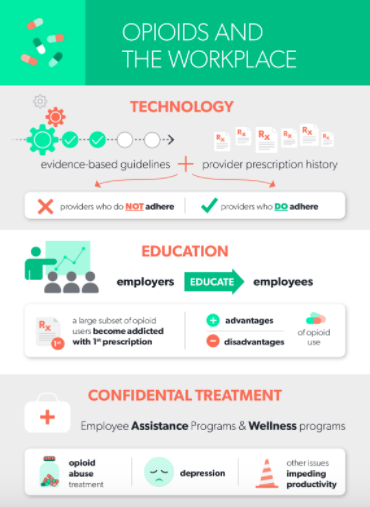America’s employers are facing a serious drug problem. A
2015 survey of 200 Indiana-based companies conducted by the National Safety Council and the Indiana Attorney General’s Office indicated that a staggering 80% of the state’s employers have had problems with employees abusing prescription opioids such as Vicodin and OxyContin.
“We would expect very similar results in many states,” said Deborah Hersman, president and CEO of the National Safety Council. The Illinois-based nonprofit organization focuses on preventing injuries and deaths at work and in the community. “This is not a local problem. This is a national problem, and it’s very important for employers to understand that this is an issue that they need to pay attention to and not put their heads in the sand.”
Prescription painkiller abuse has reached epidemic proportions across the United States. In addition to endangering the health and well-being of millions of employees, opioid abuse is costing employers billions of dollars in absenteeism and lost productivity, and growing evidence suggests that opioid abuse also affects many unemployed individuals.
“Beyond the loss of productivity, prescription drug abuse can cause impairment, injury and may lead employees to bad choices, such as theft and embezzlement from the employer,” said Indiana Attorney General Greg Zoeller in a news release about the December 2015 study.
See also: How to Attack the Opioid Crisis
Employers Feel the Pain
On average, opioid misuse costs the U.S. economy $55.7 billion a year, according to the American Society of Addiction Medicine. Employers bear the burden of nearly half of that cost, with an average of $10 billion lost every year from missed work and decreased productivity alone.
Prescription drug abuse has two effects on an employee’s medical costs. First, employees who abuse opioid drugs have significantly higher costs for pharmaceuticals than non-opioid users. Costs for opioid painkillers rose 11.5 percent in 2014, according to pharmacy benefit manager Express Scripts Holding Co. As a result, workers’ compensation claim payers spent an average of $1,583 per injured worker for prescription drugs in 2014.
Furthermore, opioid abusers have significantly higher healthcare costs than non-abusers — $10,627 higher annually — according to a research article in the Journal of Managed Care & Specialty Pharmacy.
The Illusion of Relief
While highly effective in the short term, opioids are also dangerously addictive. This is because opioids produce a sense of pleasure due to their effect on brain regions involved in reward mechanisms. Adding to their danger is the fact that opioids tend to induce tolerance, which means that over time larger and larger doses are needed to achieve the initial effect.
A 2015
Healthentic study on the cost of painkiller abuse borne by U.S. companies found that for pain related to common workplace injuries such as soft-tissue injuries (bruises and musculoskeletal problems that affect muscles, bones and joints), opioids are no more effective at reducing pain than over-the-counter alternatives such as Tylenol, Advil or generic ibuprofen.
Less risky treatments for pain include nonsteroidal anti-inflammatory drugs, nerve blockers and other medicines including anti-seizure drugs and antidepressants which have pain-relieving properties. Other important options for managing the pain of workplace injuries include physical therapy, massage and acupuncture. It is also vital to treat any concomitant depression in the injured worker, as depression makes pain feel more acute and causes the sufferer to feel hopeless and helpless.
Steps Employers Can Take
Employers have a variety of options to ensure the long-term health of employees while improving productivity and lowering employment costs. The first is to demand adherence to evidence-based prescribing guidelines for pain treatment from all participating providers in their medical, workers’ compensation and occupational health programs. There is technology available now that can alert payers to providers who prescribe according to current treatment guidelines and those who don’t.
Employers also should educate employees about the risks of opioid drug use to help prevent drug misuse. For example, employees should know that a substantial subset of opioid users become addicted with their very first prescription, so care is warranted to ensure that patients with chronic pain know both the advantages and disadvantages of taking opioids right from the start.
Lastly, employers should provide confidential access to treatment for employees who find themselves in a position of opioid dependency. Employee Assistance Programs (EAPs) or wellness programs should be able to connect employees with effective treatment programs for their opioid use disorder, their depression and whatever else is impeding their ability to full productivity.
See also: The True Face of Opioid Addiction
The Connection With Unemployment
A new study suggests unemployment also might be one of the factors behind the dramatic rise in opioid use disorder. The paper,
published by NBER, finds that as the unemployment rate increases by one percentage point in a given county, the opioid death rate rises by 3.6 percent, and emergency room visits rise by 7 percent.
Rather than more people getting injured when jobs are scarce, the authors suspect that the increased use of painkillers is a “physical manifestation of mental health problems that have long been known to rise during periods of economic decline.” Depression and pain go hand-in-hand, in other words: “Not only does depression make people more sensitive to pain,” they note, but also, “opioids have been shown to help relieve depressive symptoms.”
Pain, opioids and depression are all interrelated and all must be managed to achieve what both injured workers and payers would regard as success.
One can conclude from all of this evidence that opioid use disorder is increasingly rampant among both employees and those who are unemployed. Opioid misuse now may be a national problem, but the solution needs to start locally. Employers are uniquely positioned to demand accountability from providers and to join with their neighborhood social service agencies and nonprofits focusing on the opioid issue collectively to intervene in and reduce the prevalence of this debilitating epidemic.






